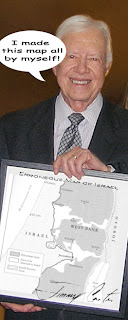 In a NY Times article, former Ambassador Dennis Ross raises some serious criticism of Jimmy Carter’s use of maps in his new book “Palestine Peace Not Apartheid.” Of course, Ross is not the first to criticize Carter for the way he uses the maps (or where he got them) to make his argument. Prof. Alan Dershowitz (see his article in the Boston Globe) has offered to debate Carter about his arguments in the book, but Carter has refused the challenge.
In a NY Times article, former Ambassador Dennis Ross raises some serious criticism of Jimmy Carter’s use of maps in his new book “Palestine Peace Not Apartheid.” Of course, Ross is not the first to criticize Carter for the way he uses the maps (or where he got them) to make his argument. Prof. Alan Dershowitz (see his article in the Boston Globe) has offered to debate Carter about his arguments in the book, but Carter has refused the challenge.
Here is the Ross op-ed from the New York Times:
Don’t Play with Maps
By Dennis Ross
I became embroiled in a controversy with former President Jimmy Carter over the use of two maps in his recent book, “Palestine Peace Not Apartheid.” While some criticized what appeared to be the misappropriation of maps I had commissioned for my book, “The Missing Peace,” my concern was always different.
I was concerned less with where the maps had originally come from — Mr. Carter has said that he used an atlas that was published after my book appeared — and more with how they were labeled. To my mind, Mr. Carter’s presentation badly misrepresents the Middle East proposals advanced by President Bill Clinton in 2000, and in so doing undermines, in a small but important way, efforts to bring peace to the region.
In his book, Mr. Carter juxtaposes two maps labeled the “Palestinian Interpretation of Clinton’s Proposal 2000” and “Israeli Interpretation of Clinton’s Proposal 2000.”
The problem is that the “Palestinian interpretation” is actually taken from an Israeli map presented during the Camp David summit meeting in July 2000, while the “Israeli interpretation” is an approximation of what President Clinton subsequently proposed in December of that year. Without knowing this, the reader is left to conclude that the Clinton proposals must have been so ambiguous and unfair that Yasir Arafat, the Palestinian leader, was justified in rejecting them. But that is simply untrue. [more]